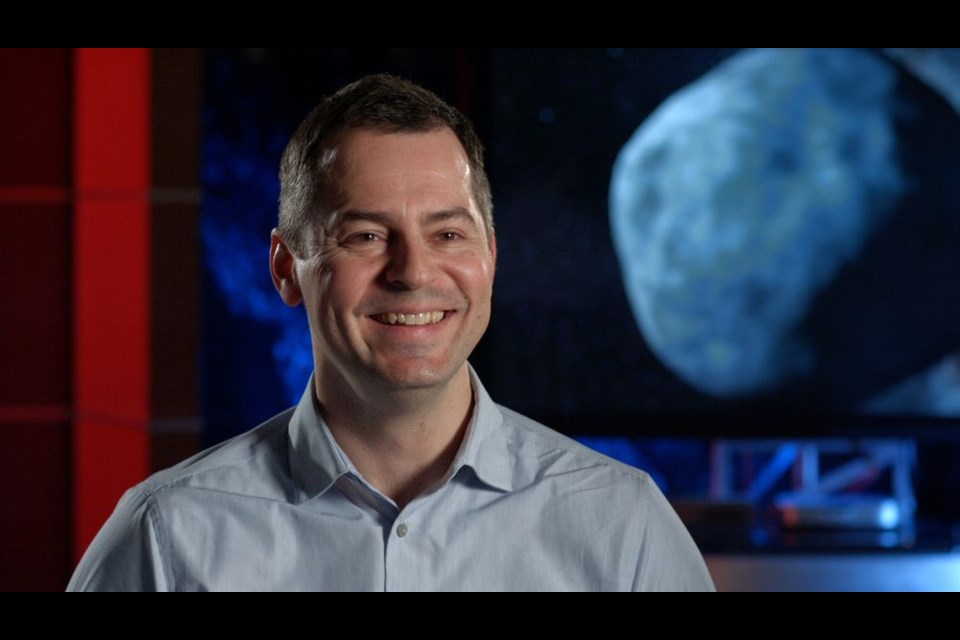Tim Haltigin, son of Linda Osachoff, has enjoyed science ever since he was a youngster in Canora.
He pursued that interest as time went on and is now the Senior Mission Scientist in Planetary Exploration at the Canadian Space Agency.
Haltigin lives in St.Constant, Quebec, with his wife Melissa and their daighters, Nora and Sasha.
He said he is presently the Canadian project scientist and mission manager of the OSIRIS-REx mission to collect samples from an asteroid named Bennu and bring it back to Earth.
“It’s an incredibly exciting mission for a number of reasons,” said Haltigin. “It’s basically allowing us to go back in time by over four billion years to understand the makeup of the early solar system, and possibly get clues as to how life started on Earth. Plus, we get to shoot lasers at asteroids.”
For the mission, Canada is contributing an instrument called the OSIRIS-REx Laser Altimeter (OLA.)
“The OLA works like a 3D scanner, using lasers to measure Bennu’s shape accurately,” said Haltigin. “We need to know the shape of the asteroid extremely well so that we can help identify sites where it’s safe for the spacecraft to collect the samples. Canada is supporting a number of scientists on the mission who will help interpret all the data we collect at the asteroid and study the samples when they come back to Earth. In return for our participation, Canada will receive some of the samples.”
Haltigin’s responsibilities on the mission include overall operations of OLA, coordinating the contributions of the Canadian science team, and ensuring the reception of the Canadian portion of the samples.
The spacecraft is scheduled to arrive at Bennu in December and create a 3D map of the asteroid.
“We’ll spend about a year using all of the instruments on the spacecraft to understand Bennu’s shape, geological composition, and physical properties,” he said. “Between now and next December we’ll be taking different measurements from distances between 7 kilometres and 225 metres away to help select where we’re going to collect the sample from. Afterwards, we’ll spend about 6 months practicing getting the spacecraft closer and closer to the asteroid, and finally collecting the samples in July of 2020.”
Haltigin said the distance from the earth to Bennu “depends on when you look.”
Based on its orbit, its distance to Earth can range from being closer than the moon to over twice the distance from the Earth to the Sun.
Since Bennu only measures about 500 metres in diameter, its gravity isn’t strong enough to land a spacecraft, Haltigin explained.
“Instead, we’ll collect the sample by extending an arm from the spacecraft and slowly flying in to make contact with the surface,” he said. “Think of it like giving Bennu a gentle high five.”
Haltigin said bringing back samples from this asteroid is an importance advancement in science.
“Asteroids are like cosmic time capsules that have preserved the chemistry of the early solar system,” he said. “They’re the leftovers of materials that went into making the planets in the beginning. By studying these samples, we’ll be able to better understand the raw ingredients of planets, and possibly even get clues as to how life started on Earth.”
Haltigin expects the benefits of this mission will continue to be realized decades into the future.
“We’ll be able to ask questions we don’t know how to ask yet and answer them with technologies that don’t yet exist.” He said. “We’re still making brand new discoveries on lunar samples almost 50 years after the Apollo astronauts brought them back from the moon. Imagine what we’re going to be able to do 50 years from now. This mission is paving the careers for generations of Canadian scientists, and I’m incredibly proud to be a part of it.”
Haltigin has been interested in science for most of his life, going back to when he attended Canora Composite School
“Part of it was going outside at night on the farm and just looking up at the sky. I was always filled with that sense of wonder, trying to understand what was out there and how we could explore it. That’s still one of my favorite things about coming home to Canora; you just don’t get skies like that anywhere else,” he recalled.
Haltigin said his career path has turned out to be anything but a straight line. In university he started by studying why malaria became resistant to certain medications, and then moved to designing structures to put in rivers to help fix trout habitats.
“After that I did a PhD comparing landscapes in the Canadian arctic with similar ones on Mars, and got hired by the Canadian Space Agency just after I finished,” he said. “Since then I’ve been really lucky to work on concepts and actual flight missions for the moon, Mars, and asteroids.”
Haltigin said his goal is to ensure that Canada plays key roles on missions throughout the solar system in the future.
He encourages students to find something that interests them, work hard and have fun doing it.
“Science isn’t about the ability to come up with all the answers, it’s about the ability to ask questions. We get stuff wrong all the time, but it’s learning from those mistakes that helps us ask a better question the next time. And more than anything, never stop being curious. There’s always something cool waiting to be discovered,” he concluded.




